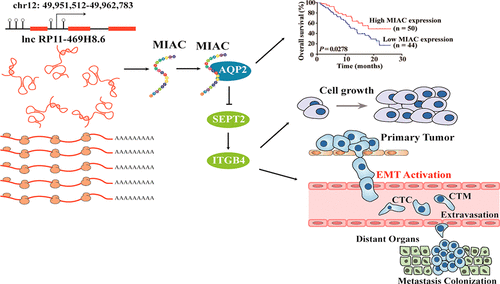

近日,国际著名学术期刊Journal of the American Chemical Society(IF 14.695)在线发表了中国药科大学生命科学与技术学院徐寒梅教授团队的最新研究成果“Micropeptide MIAC Inhibits HNSCC Progression by Interacting with Aquaporin 2”。课题组成员博士后李梦玮和硕士生李鑫为论文的共同第一作者,徐寒梅教授为通讯作者,中国药科大学为第一作者单位和第一通讯单位。江苏省口腔医院武和明主任和丁旭医生对本论文亦有重要贡献。

近年科学家研究发现长链非编码RNA (long non coding RNA, lncRNAs,lncRNA)实际包含能编码微肽 (micropeptides)的小开放阅读框 (sORF),这为蛋白质组学研究提供了一个新的视角。目前已发现的由lncRNA编码的微肽报道并不多。本研究首次在头颈鳞癌中发现由lncRNA AC025154.2编码的全新内源性微肽MIAC,体内外实验发现MIAC能抑制头颈鳞癌的增殖和转移,蛋白质谱和酵母双杂交结果显示MIAC能结合水通道蛋白,通过调控Sept2/ITGB4表达抑制骨架蛋白重排,最终抑制头颈鳞癌进展。结合500例TCGA数据库头颈鳞癌RNA-seq数据和154例临床样本检测分析证实MIAC在头颈鳞癌组织中表达显著低于癌旁组织,其表达水平与患者总生存率呈正相关,与临床病理分期,区域淋巴结转移呈负相关,提示MIAC可以作为头颈鳞癌临床诊断和预后的潜在标志物。
同时,课题组成员博士后王颖和硕士生陆继强为共同第一作者,徐寒梅教授为通讯作者在Molecular Therapy-Nucleic Acids(IF 5.919)杂志上发表了小RNA分子的最新研究。研究围绕着食管癌细胞来源的外泌体miR-181b-5p展开,解析了其调控肿瘤血管生成的分子机制,有望为食管癌患者的临床诊治和预后评估提供新型的生物标记分子和潜在的药物靶点。
此外,近三年徐寒梅教授团队在RNA与肿瘤关系的其它研究成果还发表于Clin Cancer Res (Lin C, Zhang S, Xu H*.2018 Jan 15;24(2):486-498, IF 8.911),Oncogene (Lin C, Wang Y, Xu H*. 2017 Sep 21;36(38):5392-5406, IF 6.854),Cell Death Dis (Li M, Han Y, Xu H*. 2018 Jan 24;9(2):91, IF 5.959)等杂志上。
Abstract
Several important micropeptides encoded by noncoding RNAs have been identified in recent years; however, there have never been any reports of micropeptides in head and neck squamous cell carcinoma (HNSCC). Here we report the discovery and characterization of a human endogenous peptide named micropeptide inhibiting actin cytoskeleton (MIAC). Comprehensive analysis of the TCGA (The Cancer Genome Atlas) database (n = 500), clinical fresh samples (n = 94), and tissue microarrays (n = 60) revealed that lower MIAC expression is correlated with poor overall survival of HNSCC patients. Meanwhile, RNA-sequencing analysis of 9657 human tissues across 32 cancer types from TCGA cohorts found that MIAC is significantly associated with the progression of 5 other different tumors. Mechanistically, MIAC directly interacts with AQP2 (Aquaporin 2) to inhibit the actin cytoskeleton by regulating SEPT2 (Septin 2)/ITGB4 (Integrin Beta 4) and ultimately suppressing the tumor growth and metastasis of HNSCC. Collectively, the mechanism investigation and evaluation of MIAC activity in vivo and in vitro highlights that MIAC plays an important role in HNSCC tumorigenesis.
声明:化学加刊发或者转载此文只是出于传递、分享更多信息之目的,并不意味认同其观点或证实其描述。若有来源标注错误或侵犯了您的合法权益,请作者持权属证明与本网联系,我们将及时更正、删除,谢谢。 电话:18676881059,邮箱:gongjian@huaxuejia.cn